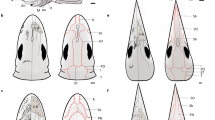Summary
With the use of a whole mount silver impregnation technique, sensory nerve endings were located in the connective tissue at the base of the modified pectoral fin ray in the gurnard,Aspitrigla cuculus, and within the perichondrium of the barbel in the goatfish,Mullus surmuletus. The location of these endings and their planar receptory fields in such highly mobile structures, suggests that the sensory endings are proprioceptive in nature and that they are associated in monitoring the positional state of the modified pectoral fin ray and barbel, respectively, during voluntary movement. This investigation addresses itself to the general problem of proprioception in teleost fishes and provides histological evidence for the presence of proprioceptive nerve endings.
Similar content being viewed by others
References
Ballintijn, C.M., Bamford, O.S.: Proprioceptive motor control in fish respiration. J. exp. Biol.,62, 99–114 (1975)
Bardach, J.E., Case, J.: Sensory capabilities of the modified fins of squirrel hake (Urophycis chuss) and searobins (Prionotus carolinus andP. evolans). Copeia., (2), 194–206 (1965)
Barker, D.: Muscle Receptors. Handbook of Sensory Physiology. Vol. III/2, pp. 1–310. Springer-Verlag (1974)
Belling, D.E.: Der Bau der vorderen paarigen ExtremitÄten und des Schultergürtels der Trigla im Zusammenhang mit dem Bau entsprechender Organe bei anderen Teleostei. Bull. Soc. Imp. Nat. Moscou Année 1911, 46–92 (1912)
Bone, Q.: Some notes on histological methods for peripheral nerves. Med. Lab. Tech.,29, 319–324 (1972)
Bone, Q.: Patterns of muscular innervation in the lower chordates. Int. Rev. of Neurobiol.,6, 99–147 (1964)
Ciaccio, G.V.: Sur les plaques nerveuses finales dans les tendons des vertébrés. Archiv. Ital. de Biol.,14, 31–57 (1890–91)
Fessard, A., Sand, A.: Stretch receptors in the muscles of fishes. J. exp. Biol.,14(4), 383–404 (1937)
Herrick, C.J.: The tactile centers in the spinal cord and brain of the sea robin,Prionotus carolinus L. J. Comp. Neurol. and Psychol.,17 (4), 307–327 (1907)
Holmes, W.: (1967). — Cited by D. Barker, Muscle Receptors. Handbook of Sensory Physiology. Vol. III/2. pp. 137. Springer-Verlag, (1974)
Jobert, M.: Etudes d'anatomie comparée sur les organes du toucher chez divers mammifères, oiseaux, poissons et insectes. Annls. Sci. nat, (5 Zool.)16, 1–160 (1872)
Lowenstein, O.: Pressure receptors in the fins of the dogfish,Scyliorhinus canicula. J. exp. Biol.,33, 417–421 (1956)
Morrill, A.D.: The pectoral appendages ofPrionotus and their innervation. J. Morph.,11, 177–197 (1895)
Pansini, S.: Delle terminazioni dei nervi sui tendini nei Vertebrati. Boll. Soc. Nat. Napoli., (1)2, 135–160 (1888)
Poláček, P.: Receptors of the joints, their structure, variability, and classification. Acta. Facult. Med. Universit. Brünn.,23, 1–107 (1966)
Poloumordwinoff, D.: Recherches sur les terminaisons nerveuses sensitives dans les muscles volontaires. Société Scientifique et Station Zoologique d'Arcachon.,3, 73–79 (1898)
Roberts, B.: The response of a proprioceptor to the undulatory movements of dogfish. J. exp. Biol.,51, 775–785 (1969)
Sato, M.: Preliminary report on the barbels of a Japanese goatfish,Upeneoides bensasi (Temminck and Schlegel), Sci. Rep. Tohoku Imp. Univ., Biol.,11, 259–264 (1937a)
Scharrer, E.: Intraepithelial nerve terminals in the free finrays of the searobin,Prionotus carolinus. L. Anat. Rec,145 (2), 367–368 (1963)
Sharrer, E., Smith, S.W., Palay, S.L.: Chemical sense and taste in the fishesPrionotus andTrichogaster. J. Comp. Neurol.,86, 183–198 (1947)
Tiedemann, V.: Von dem Hirn und den fingerförmigen FortsÄtzen der Triglen. Meckel's Arch.,2, 103–110 (1816)
Winkelmann, R.K., Schmitt, R.W.: A simple silver method for nerve axoplasm. Proc. Staff Meeting Mayo Clinic,32, 217 (1957)
Wunderer, H.: über Terminalkörperchen der Anamnien. Archiv für mikroskop. Anat. Entwicklungs-mech.71, 504–569 (1908)
Author information
Authors and Affiliations
Rights and permissions
About this article
Cite this article
Ono, R.D. Sensory nerve endings of highly mobile structures in two marine teleost fishes. Zoomorphologie 92, 107–114 (1979). https://doi.org/10.1007/BF01001533
Received:
Issue Date:
DOI: https://doi.org/10.1007/BF01001533




